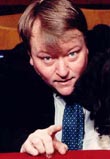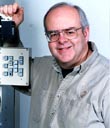|
|
This topic comprises 2 pages: 1 2
|
|
Author
|
Topic: Pulse lamps........
|
|
|
|
|
Hugh McCullough
Expert Film Handler

Posts: 147
From: Old Coulsdon, Surrey, UK
Registered: Jan 2003
|
 posted 10-13-2003 05:53 PM
posted 10-13-2003 05:53 PM





Pulse lamps were a Philips invention, and I remember using them at the ABC Croydon when we were testing out the, then, new FP20 projectors in the late 1960s.
The projector was not fitted with a flicker shutter, instead the lamp flickered on and off, being on when the film was stationary in the gate, and off when the film was moving to the next frame.
The idea may have seemed good, but did not work as the lamps life span was not very long, and the constant on-off-on cycle weakened the filament. They were also not very bright, at least not on our 135ft throw.
After about 18 months we installed a flicker shutter, and went back to our Peerless carbon arcs.
The last time I saw one of these lamps in use was on a Philips slide projector sometime in the midd 1970s.
| IP: Logged
|
|
|
|
|
|
|
|
|
|
Stephen Furley
Film God

Posts: 3059
From: Coulsdon, Croydon, England
Registered: May 2002
|
 posted 10-13-2003 06:31 PM
posted 10-13-2003 06:31 PM




How widely used were these things? The first time I heard of them was at college in about 1974, where one of the lecturers happened to mention them. He had used them somewhere, I don't know where, but wasn't very impressed, for the same reasons you gave, Hugh, short life and low light output, also poor colour. He said they were replaced by carbon arcs. Since then I have heard of them several more times, but have never heard very good reports of them.
The two projection lecturers were Ted Church and Harry Court; did you know either of them?
Hugh wrote:
quote:
They were not watercooled.
But Pete wrote:
quote:
I seem to recall they were water cooled
Hugh also said that his lamps were prototypes; maybe the water cooled ones were a later development, to increase the available light output.
Pete, I'm quite surprised that these lamps were still in use in the '70s, maybe as the QEH only ran film on an occasional basis they didn't think it was worth replacing them with something better. I would be very surprised indeed if any were still in use today.
Philips, and later Kinoton were always very innovative, with such things as long run film handling, automation systems, single projector systems etc, and later, of course, platters. Philips are also a very major producer of discharge lamps of various types, so it is not surprising that they would have developed these.
They also made a remarkable projector, with two mechanisms, one above the other, and four 2000 foot spoolboxes. Two projectors in the space of one.
| IP: Logged
|
|
Per Hauberg
Jedi Master Film Handler

Posts: 883
From: Malling, Denmark
Registered: Jul 2000
|
 posted 10-13-2003 06:43 PM
posted 10-13-2003 06:43 PM





The pulse lamps were, if I am not all wrong, presented together with the first FP20's at the 1956 Photokina exhibit in Cologne, Germany, as Philips' go for automation. Two FP20 projectors with pulse lights and 6000 feet reels automatic change-over was the future small and medium cinema. At the very same exhibition the DP70 was showing "The Miracle of Todd-AO".
The pulse lamps were water-cooled, and due to the short lifetime of the bulbs, a spare bulb was mounted with the one in use, changing automatically to the new one, when the first burned out. Black-out, yes - but the change was quite fast and the lamphouse just "cute". The Philips trade paper "The Elagraph" had an article with pictures from the occasion. Maybe Thomas Hauerslev has got this in his archives to share.
p.
| IP: Logged
|
|
|
|
|
|
|
|
|
|
|
|
|
|
|
|
All times are Central (GMT -6:00)
|
This topic comprises 2 pages: 1 2
|
Powered by Infopop Corporation
UBB.classicTM
6.3.1.2
The Film-Tech Forums are designed for various members related to the cinema industry to express their opinions, viewpoints and testimonials on various products, services and events based upon speculation, personal knowledge and factual information through use, therefore all views represented here allow no liability upon the publishers of this web site and the owners of said views assume no liability for any ill will resulting from these postings. The posts made here are for educational as well as entertainment purposes and as such anyone viewing this portion of the website must accept these views as statements of the author of that opinion
and agrees to release the authors from any and all liability.
|

 Home
Home
 Products
Products
 Store
Store
 Forum
Forum
 Warehouse
Warehouse
 Contact Us
Contact Us




 Printer-friendly view of this topic
Printer-friendly view of this topic
















